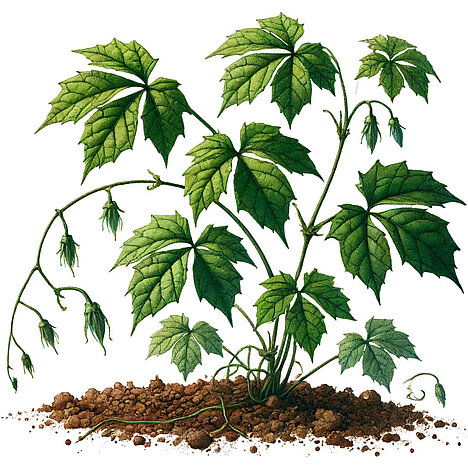Self-climbing maiden vine

When it comes to greening our garden, we are often faced with the challenge of choosing plants that are not only aesthetically pleasing, but also safe for our four-legged friends. The self-climbing maidenhair vine, also known by its scientific name Parthenocissus, is a popular choice for many gardeners looking to beautify their outdoor space with a fast-growing, dense greenery. However, while this plant undoubtedly offers many benefits, dog owners should also be aware of the potential risks it can pose to their pets. In this article, we take an in-depth look at the self-climbing maiden vine, examine its characteristics and assess whether it is a suitable choice for households with dogs.
What is the self-climbing maiden vine?
The self-climbing maiden vine belongs to the vine family and is known for its fast growth and ability to climb up walls and fences without additional support. This characteristic makes it a popular choice for natural façade greening and privacy screens in gardens. Their leaves, which appear in different shades of green depending on the species, often turn spectacular shades of red and orange in the fall, creating a stunning autumnal spectacle.
Advantages of the self-climbing maiden vine
Easy care and fast growth
One of the biggest advantages of this plant is its rapid growth and low maintenance requirements. It can cover large areas with greenery relatively quickly and therefore offers an efficient solution for garden design.
Natural privacy screen
Due to its dense leaf cover, the self-climbing maidenhair vine provides an excellent natural privacy screen that keeps out prying eyes while creating a green backdrop.
Autumnal blaze of color
The spectacular autumnal color change of the leaves from green to red or orange is a visual highlight and adds another seasonal dimension to any garden.
Disadvantages and risks for dogs
Potential toxicity
Some species of maidenhair vine can be toxic to dogs. If a dog consumes parts of this plant, symptoms such as vomiting, diarrhea, tremors or lethargy may occur. The berries of the plant in particular are considered poisonous.
Skin irritation
Contact with the sap of the plant can cause skin irritation in some dogs. While this is less of an ingestion issue, dog owners should be careful if their dog tends to roam through dense undergrowth.
Choking hazard
The dense vines and leaves of the plant, if torn off and ingested, can be a potential choking hazard for dogs.
Better safe than sorry
While the self-climbing maidenhair vine undoubtedly offers many benefits for landscaping, caution is advised if dogs live in the household. The potential toxicity of some species and the risk of skin irritation or even choking make it necessary to choose and place this plant with care. It is advisable to find out about the specific species of maidenhair vine before planting and ensure that it is safe for pets. Ultimately, the safety of our furry friends should always take priority. There are numerous other garden plants that are both safe and aesthetically pleasing and can be an excellent alternative to the self-climbing maiden vine.
If you notice any signs of hypersensitivity or poisoning in your dog, you should see your vet immediately. We are not a substitute for a vet, but we try to be as accurate as possible. Every dog reacts differently and we recommend you get a second opinion or consult your vet if in doubt.
Stay healthy and take good care of your four-legged friend!😊